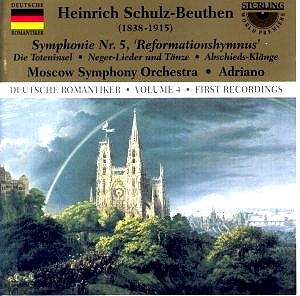This adventurous album is released in Sterling’s ‘Deutsche
Romantiker’ series and, once again, we have Adriano to thank for unearthing
more interesting Late Romantic gems. As he says in his erudite notes
(for this album he also edited the manuscript of the main work, Schulz-Beuthen’s
‘Reformation Symphony’), the works of Brahms, Bruckner, Mahler and Richard
Strauss have tended to overshadow so much other Late Romantic German
music of which the work of Heinrich Schulz-Beuthen is just one example.
Schulz-Beuthen’s Symphony No. 5 (The Reformation Symphony)
is, as Rob Barnett has pointed out in his review of this recording also
on this site, is based on Martin Luther’s 1529 hymn, Ein fest burg
ist unser Gott. Schulz-Beuthen may well have had Luther’s 400th
anniversary in mind when he composed this 18+ minute work. The opening
movement opens powerfully and proceeds in pomp and swagger with chivalric
motifs and grand flourishes for music that Elgar would have marked nobilmente.
Indeed there is a little to remind one of Elgar here; but there
is, alas, just that bit of banality too that reminds this reviewer of
music for the silent cinema. The second more successful movement begins
with the organ, cello and later woodwinds in a quieter lyrical mood,
intoning a theme, the beauty of which develops with each repetition.
This theme alternates with louder, dignified, stately ecclesiastical
material. The third movement returns to the swagger of the first movement
with fanfares blazing. The finale builds on this mood so that the work
ends after a solemn processional, and serener solo religioso
material for the organ, in a huge climax like that of Saint-Saëns
Organ Symphony. Although this symphony can in no way rival that work
or Alexander Guilmant’s Symphony No. 1 for Organ and Orchestra, it has
to be an action adventure film director’s dream.
The most satisfying work in this programme is Die
Toteninsel (The Isle of the Dead) composed in 1909. It is every
bit as dramatic and effective as Rachmaninov’s more famous composition
and Max Reger’s version within his Böcklin Suite. [Böcklin
seems to have been very preoccupied with this subject for he painted
this gloomy but powerfully evocative scene in five different versions
between 1880 and 1886]. The power of the opening with darkly commanding
throaty brass has great impact and creates a brooding, funereal atmosphere.
This material on each of its successive return carries more than a hint
of menace and there is a very atmospheric and convincing evocation of
the little boat sailing over deep and turbulent waters towards the mysterious
island with its towering mausoleum cliffs and cypress trees. But Schulz-Beuthen
also has a luscious romantic theme for his lyrical interludes suggesting
the loves and serener domestic life of the deceased and the expressive
cello solo in the centre of the tone poem hints at some personal tragedy
or loss.
The Negro Songs and Dances are charming and
unpretentious melodious little pieces that may have originated in the
U.S.A. but sound equally middle-European in Schulz-Beuthen’s adaptations.
The best-known piece is the well-known song Oh Susannah! - given
a nicely sentimental, nostalgic air here. The opening Allegro animato
trips and trots along genially with plenty of exercise for the triangle
which returns upstage in the merry dance that is the fourth Allegro
movement. The second piece, Moderato assai is a bitter sweet
salon confection that yearns and sighs - and it might well have been
penned by Brahms. Tambourine is to the fore with brass interjections
in the Allegretto con spirito, gaio assai. This is followed by
the coy sad little Moderato, molto malinconico. In higher spirits
comes an Allegretto scherzando, a rustic dance that bubbles and
laughs its way along. An Andantino doloroso brings back the clouds
but the piece ends in determined optimism (Solenne e maestoso: Andante)
with fanfares dominating over cosy nostalgia.
The equally charming Sounds of Farewell is a
little suite for strings that seems to carry over the character and
atmosphere of the Negro Songs and Dances into its vivacious opening
movement, there are those lively trotting rhythms and the nostalgic
cosiness again. The second movement is a lovely sweeping, yearningly
romantic melody that had me thinking of Elgar’s Serenade for Strings.
The Allegretto moderato, third movement trips along prettily
and then proudly shrugs in its centre. The fourth piece is quieter and
autumnally reflective.
Once again Adriano has unearthed some appealing music
that deserves to be more widely known – particularly Schulz-Beuthen’s
version of The Isle of the Dead. This may not be the cream of
Late Romantic German music but it could lay claim to being near ‘the
top of the milk’.
Ian Lace
See also Review
by Rob Barnett
